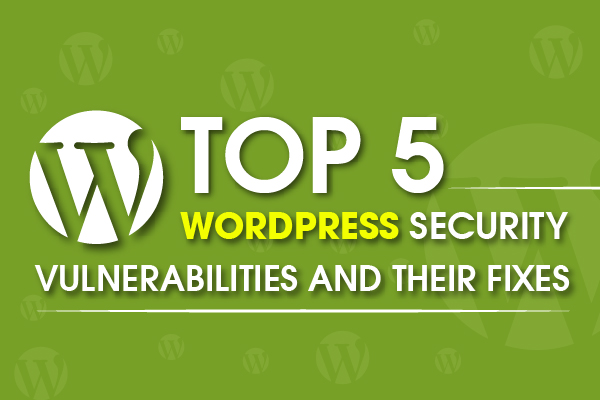Most Common WordPress Security Vulnerabilities You Should Be Aware Of
A WordPress website is susceptible to numerous security vulnerabilities and hackers can take advantage of these vulnerabilities to gain access to your website. Once hackers infiltrate your site, they can use it to carry out a wide range of malicious activities including sending spam emails, launching other websites, stealing website data, stealing visitor details and information, storing files, etc.
Things can actually go from bad to worse for you because Google will blacklist a website once they know it is hacked. In addition to that, your wordpress hosting provider can suspend your site.
The good news is, there are security measures you can take to keep your WordPress website safe from hackers. What we’ll be doing in this article is to first, show you how to find the most common WordPress vulnerabilities, and second, show you how you can fix them.

Common WordPress Security Vulnerabilities and How to Fix Them
1. Out-of-Date Themes and Plugins
WordPress themes and plugins, just like any other software, have the tendency to develop vulnerabilities. Once developers discover these vulnerabilities, they promptly fix them and release a security patch as an update.
When website owners keep using out-of-date WordPress themes and plugins, the site becomes susceptible to attacks from hackers who actively search for vulnerable plugins and themes on WordPress sites in order to exploit them.
How To Ensure Your WordPress Website Is Updated?
Ensuring your website is updated can be quite difficult. New updates are being rolled out regularly which makes it challenging to implement all of them. This is even more challenging if you have to install updates on multiple websites.
The solution is to have a plan in place where you set aside a day every week to install updates on all your sites.
You have to be cautious about updates, however, because some of them are known to break websites. A few years ago, WooCommerce rolled out a major update that broke a lot of websites creating loads of problems for e-commerce website owners at the time.
The safest way to update your website without breaking it is to test the update in a staging environment. All you have to do is install a WordPress staging plugin then check whether the update will cause any problems for your site. Once you’re happy with the results you get on the staging site, you can then go ahead and apply the update to the live site.
Instead of using a nulled or out-of-date theme, you might want to sign up with web hosting companies such as Bluehost Or Wix that provide free website builders for their customers - you can read an in-depth comparison between Bluehost vs. Wix here on Mamboserver.
2. Pirated Themes and Plugins
Pirated software is another very common security vulnerability that WordPress websites are susceptible to.
Pirated WordPress plugins and themes grant you access to the premium versions of these software for free. With website owners trying to cut down on costs, there is a temptation to use pirated plugins and themes for their WordPress sites instead of purchasing the premium versions of the software.
This poses security risks as pirated software often contains malware and backdoor software. Once installed on your website, the malware infects your site, while the backdoor provides an entry point for hackers to enter and take control of your site.
The minute you install pirated themes and plugins, your site becomes compromised. Therefore, even though they are very tempting, you should, at all costs, avoid installing pirated software on your website.
How Do You Keep Your Site Safe From Pirated Software?
This can be achieved by doing 2 things;
a) Uninstall All Pirated Plugins and Themes on Your Website
Remove all pirated themes and plugins from your website. Furthermore, if you notice any theme or plugin that you can’t remember installing on your website, there’s every possibility it’s from a hack. You should immediately remove the software from your site.
Also, you can scan your website with a WordPress malware scanner. After running the scan, the tool will show you any infected files found on your website. You can clean them out using the malware removal option.
b) Buy Or Download Your Plugins From Trusted Sources Only
Ensure that you get all your themes and plugins only from the WordPress repository or from trusted sources like Creative Market, ThemeIsle, WPExplorer, ThemeForest, etc.
3. WordPress Login Page
The login page gives you access to your WordPress admin dashboard. This explains why it’s a prime target for hackers. Besides, it’s easy to land on the login page of a WordPress site because they all come with the same default login page; website.com/wp-admin.
Hackers hardly try to infiltrate the login page themselves. They use bots to open a WordPress login page where they try out the different username and password combinations. If your login credentials are easy to remember, for instance: username – admin, password – p@ssw0rd, the bots will crack it within a couple of minutes. Hackers will then have access to your site and start carrying out malicious activity. This is known as a brute force attack. The only way to avoid these types of attacks is to use a strong and distinctive username and password combination.
How Do You Create Strong Login Credentials?
There is a requirement to enter a username and password on your WordPress site and both of these have to be strong. The key is to make it as hard as possible for a hacker to guess your login credentials. Using a strong combination of username and password can greatly reduce the chances of a hacker infiltrating your website.
a) Create Strong Usernames
A lot of site owners focus only on setting up a strong password while often ignoring the username. However, if it’s easy to guess the username, all the hacker has to do is figure out the password. Therefore, the username is your first line of defense from brute force attacks and it should be taken seriously.
All the usernames on your site should be unique. This can be achieved in 3 ways;
- Avoid using common usernames such as admin, admin123, etc.
- Avoid usernames that already appear on your site. For instance, if you publish your articles under the name Dave, then Dave should not be your admin username. Hackers often look for names on a website to try them out on the login page.
- You have to adopt these measures across the board for all users. Each user on your WordPress dashboard needs to change their login username to something unique.
b) Create Strong Passwords
We often have a tendency to use weak passwords because we can remember them easily. But hackers can effortlessly guess the password during a brute force attack and gain access to your site.
WordPress recommends that you use a strong password but it is not mandatory. So it’s left for the website owners to make sure each user is using a strong password.
You can set up a strong password in a couple of ways;
- Auto-generate a Strong Password From WordPress
- Step 1: Login into your WordPress dashboard. Go to the menu on the left side of your screen, select User > All Users
- Step 2: Choose Edit, this takes you to your WordPress User profile
- Step 3: On the WordPress User profile, click on “Generate Password”
This generates a new password with a combination of numbers and special characters.
Make sure you hit “Save” before exiting the page.
- Create a Strong Password With a Long Passphrase
It is possible to create a strong password by yourself using passphrases as passwords. Passphrases are easy to remember but very difficult for hackers to crack. For example;
Long password: pY84XdwalpamGTvn%$)bqz9swJJ2!u (hard to remember)
Long passphrase: I love writing about technological innovations (easy to remember)
4. Incorrectly Assigned WordPress Roles
For a new WordPress site, an administrator account is created by default. Then you start to create new user accounts and assign roles to these users. Each role has its own sets of powers and responsibilities.
One common mistake a lot of website owners make is they assign admin roles to all the users. Admins have total control over the website, as such, putting administrative powers in the wrong hands could prove to be a costly mistake which can have serious consequences for a website.
There are six types of user roles on WordPress with hierarchical powers that decrease as you go down the ladder.
- Administrator – Can access all features. Has absolute control over the whole website.
- Editor – Power to manage and publish all posts.
- Author – Has the power to publish and manage just their own posts.
- Contributor – Able to write and draft own posts but don’t have powers to publish them.
- Subscriber – Can only manage own profile.
How To Assign The Correct User Roles?
Firstly, consider carefully which roles you would assign to which users. It’s best to have just 2 or 3 admin users.
To assign/change user roles, this is what you should do;
- Step 1: Login into your WordPress dashboard. Go to the menu on the left side of your screen, select User > All Users
- Step 2: Choose Edit, this takes you to your WordPress User profile
- Step 3: On the WordPress User profile, assign a new role to the user
5. Running Your Website on HTTP
HTTP (HyperText Transfer Protocol) is a protocol that helps to establish a connection between a browser and a web server.
To know if a website is running HTTP, take a look at the URL of the website. If the URL begins with “http://” then, the website is on HTTP.
HTTP is not secure. With HTTP, the data sent across the internet between browsers and web servers are not encrypted. It is sent in plain text, so if hackers intercept the data, they can read it. For instance, a visitor is submitting their credit card details on your website, and your site is running on the insecure HTTP, it will be easy for anyone to intercept the connection and steal the visitor’s data (information).
To safeguard your website from these types of attacks, you would have to switch to HTTPS (HyperText Transfer Protocol Secure). This protocol ensures that the data going from a visitor’s browser to the website server is encrypted. Therefore, even if hackers intercept and steal the data, they won’t be able to read it.
How Do You Move From HTTP To HTTPS?
To move your WordPress from HTTP to HTTPS, you would need to install an SSL certificate. These certificates are available from your hosting providers or reliable SSL Certificate Providers.
Furthermore, there are paid certificates as well as free ones. If you’re thinking about which one to go for, paid certificates are better because, in addition to your SSL certificate, you get support, warranty, and long validity. You can compare the difference Free SSL vs. Paid SSL
Conclusion
Website security is not something you can take lightly. Hackers are always looking for new ways to hack websites. However, if you implement all the measures described above, you will be greatly reducing the chances of your WordPress website getting hacked.


